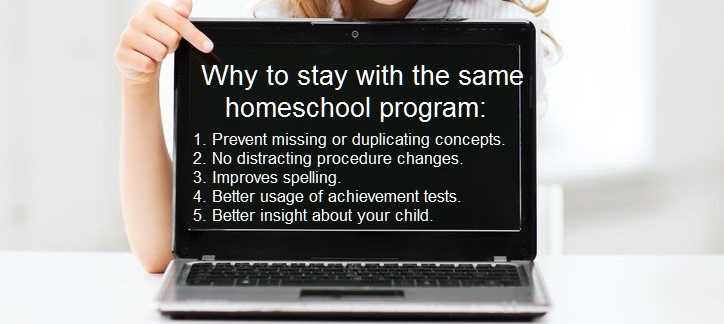 K12 Homeschool
K12 Homeschool
K12 Homeschool Program: Five points why to stay with the same homeschool program!
It is highly beneficial to stay with the same curriculum or K12 homeschool program across all grade levels. This is so the student will not miss or duplicate concepts. Staying with the same K12 homeschool program keeps the student from having to learn different publisher formats, procedures and online structures every year. The same K12 homeschool program or curriculum can improve the mastery of spelling. The same k12 homeschool program or curriculum can allow better use of achievement tests as originally intended–to help the student. Staying with the same program can offer additional academic insight that you may miss when changing homeschool programs.
 You can miss or duplicate concepts!
You can miss or duplicate concepts!
National curriculum standards have been created to encourage publishers and schools “when” to cover precise concepts at certain grade levels. Many publishers and schools deviate from these standards. We are not talking about “what” to teach, but “when” to teach. Some introduce concepts ahead of schedule because they have a “teach to test” mentality. Most achievement tests include a percentage of advanced questions to see if a student is above grade level. Publishers and schools have pressure to have higher annual test scores. In order to do that, concepts are introduced ahead of time to help answer the advanced achievement test questions. Usually at the sacrifice of broader mastery. The failure for publishers and schools to follow standards can create major problems for students that switch curriculum, programs or schools.
Example Situations.
Example situation of going from a “teach to test” program to a “broad learning” program: Why it happens? Some curricula or schools introduce grade-level concepts a year early for achievement test benefit. Some don’t. What happens? The “teach to test” program will introduce concepts a year or more early to give a better test score image. Some students struggle to master higher grade-level concepts early. Some will also lose broader learning for their current grade level due to covering higher grade-level concepts. These issues will cause the family to look for a different program or school. When the student switches to a “broad learning” program that is following standards, the student may have some previously covered material. Redundant work can cause student boredom and frustration. That is why it is good to consider an individualized curriculum or program.

Example situation of going from a “broad learning” program to a “teach to test” program: Why it happens? Some parents switch to a “teach to test” program because they want to see higher achievement test scores. Sometimes the parents switch just from complaints the student is bored with a more mastery-based approach. What happens? The “teach to test” program for a specific grade level may already be past certain concepts compared to the previous “broad learning” program. This may create gaps in learning. Missing foundational concepts can cause a chain reaction of academic struggles. That is why it is good to consider an individualized curriculum or program.
The main point is each curriculum, program or school can be different in scope and sequence and how concepts are spiraled through the grades. Switching can cause learning gaps or duplication or both. It is good to stay with the same curriculum or program if possible.
Prevents unnecessary distractions.
Each curriculum will have different procedures and a different format. Each program or school will have different procedures and structures. Staying with the same program structure is one less area to distract from learning. It is also one less area for the supervising parent to master! Even the transition from 8th grade to high school curriculum is advantageous if it is from the same publisher or program. It is no surprise that students enrolled in multiple schools over their K-12 career perform worse. A Colorado Department of Education study done in 2012 verified this factor, but went on to say that students enrolling in online schools have a history of being enrolled in more schools than other students. Their study also stated that students that stayed with the same online program for four or more years did as well or even better than campus-based students.
Improves spelling.
Each curriculum publisher divides its master spelling word list differently by grades. A different publisher might cover words in 3rd grade that are covered by another publisher in 4th grade, or vice versa. Depending on the situation, a student will either repeat learning words or miss them altogether if switching K12 homeschool programs.
Spelling is not a single subject. Often publishers introduce spelling words in multiple subjects other than Spelling or Etymology to provide extra exposure and usage of each word. For example, when the word “achievement” is introduced in the spelling curriculum, it is also introduced in that grade level of science and social studies content for additional exposure and mastery. If piecing together curriculum or using different publishers for different subjects, you will miss this curriculum strength. It may also make the verbiage in science and social studies more challenging if the spelling curriculum does not match the other subjects’ introduction of new words.
Can actually use achievement tests to improve learning.
Achievement tests will assess student achievement. It is beneficial to use a different publisher than the curriculum publisher. It is very beneficial to use the same achievement test each year. You should use achievement tests to evaluate annual growth in each academic area for an individual student. This is normally done by comparing the student’s previous stanine or sten scores with the current year’s test results. If there is not sufficient growth in an area, the parent knows where to concentrate.
Although tests might be beneficial to compare students, the primary purpose of achievement tests are not to compare against other students, but to show the rate of progress for the individual in each academic area. All too often, educators will look at scores to compare with other students’ results, then will forget the test’s other benefits. Parents have a tendency to focus on the less accurate grade level rating for each test area rather than growth over the previous year.
A common reaction to improve growth in an academic area is to switch to a curriculum that introduces advanced concepts earlier. Switching may allow the student to answer more advanced questions next year to raise the score. It still does not fix the foundational reasons for why the student is not correctly answering more of his grade level questions. Switching to a “teach to test” program may just mask real problems! Staying with the same curriculum allows parents to focus on the exact area of need rather than take a wild shot that another curriculum will fix it.

Additional insight from others.
Many homeschoolers are now using K12 homeschool programs, online Christian schools, online charter schools, and other distance learning options rather than doing it all on their own. Staying with the same program allows people at these programs to learn more about your child’s academic situation from multiple years of interaction. Academic counselors have more time to evaluate student needs when the student is not new to the program. Often, the student may have the same subject teacher for multiple years in programs that offer teacher support. The program’s achievement testing is likely to be the same test each year. Even if it is a different grade level, the format and procedures will be the same. This removes the additional distraction of a new test. As mentioned above, the same test used over multiple years can show growth more accurately.
If you visited this page before our website revamp, you can find the previous content on the “Ten points to review before choosing a homeschool program” page.
Please contact us if you know of another reason to stay with the same program or school for 12 years.